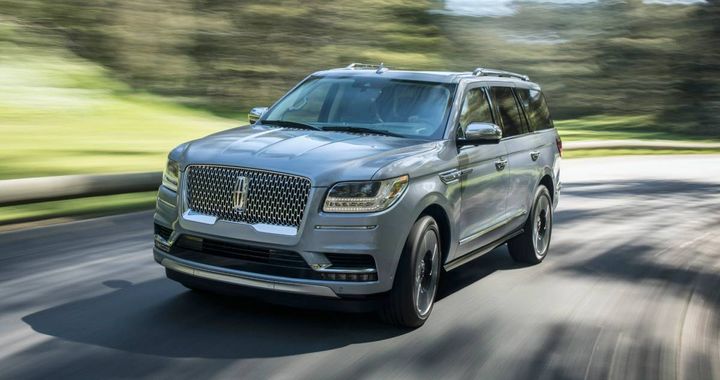
Values of used vehicles, such as this 2018 Lincoln Navigator, should wane somewhat after Q2 and see closer to normal price depreciation patterns for the rest of the year.
Photo: Lincoln
Wholesale used-vehicle prices (on a mix-, mileage-, and seasonally adjusted basis) declined 3.3% month over month in March, according to a Cox Automotive analysis released April 7. This brought the Manheim Used Vehicle Value Index (MUVVI) to 223.5, an increase of 25% from a year ago. The non-seasonally adjusted price change in March increased 0.6% compared to February, leaving the unadjusted average price up 23% year over year.
“We anticipate the second quarter – and particularly April – will be the strongest part of the year for used vehicle sales and values,” said Cox Automotive chief economist Jonathan Smoke in a news release. “Once we get through the spring, we expect demand to wane somewhat and should see closer to normal price depreciation patterns for the rest of the year. That said, we think our call for not expecting a price crash in 2022 – just depreciation – is still very likely given continued challenges with supply conditions.”
Manheim Market Report (MMR) values saw weekly price increases that accelerated in each full week of March after the first week saw the smallest decline thus far this year. MMR is a valuation tool used by tens of thousands of consignors and dealers to assess millions of trade-ins each month. It is designed to be highly stable and avoid overreacting to short-term market ups and downs to provide an accurate measure of vehicle valuations regardless of market conditions.
Over the last four weeks, the Three-Year-Old Index increased a net 1.2%. In the same period, daily MMR Retention, which is the average difference in price relative to current MMR, averaged 99.6%, which meant that market prices were slightly behind MMR values. The average daily sales conversion rate in March increased month over month to 57% but remained below the normal level for this time of year. For example, the sales conversion rate averaged 62.7% in March 2019. The lower conversion rate indicates that the month saw buyers with more bargaining power than is normal at this time of year, but the sales conversion rate increased as March progressed. A higher conversion rate signals more buyer interest and more competition for vehicles.
All major market segments saw seasonally adjusted prices that were higher year over year in March. Vans had the largest year-over-year gains, followed by compact cars, while pickups and luxury cars lagged the overall market. On a month-over-month basis, all major segments saw seasonally adjusted price declines, with pickups declining the most. The seasonal adjustment drove most of the declines. Most major market segments saw price gains from February, with midsize and compact cars increasing the most, while vans declined.
“Recent declines in the MUVVI are driven mostly by the seasonal adjustments. In fact, the wholesale used-vehicle market was gaining strength in the final weeks of Q1, a sign the spring bounce is finally here,” said Chris Frey, senior manager of economic and industry insights, Cox Automotive. “We expect to see strengthening wholesale values in April and May, with an uptick in demand for used vehicles, driven in part by tax refunds putting more cash into the economy.”
Delayed Tax Refunds Lead to Used Sales Being Down in March
Leveraging a same-store set of dealerships selected to represent the country from Dealertrack, Cox Automotive estimates that used retail sales increased 37% in March from February but failed to show the typically larger seasonal increase driven by tax refund season. These estimates indicate that used retail sales were down 15% year over year.
The issuance of tax refunds is several weeks behind the normal pace. Based on IRS statistics through March 22, about 45% of this year’s likely volume of tax refunds had been issued, when for the same week in 2019, 71% had been disbursed. The market will likely see a stronger April performance as most refunds expected will have been distributed as the month begins, and the average refund amount is at a new record and up 12% year over year.
Using estimates of used retail days’ supply based on vAuto Available Inventory data, March supply ended at 44 days, down from 53 days at the end of February but up from 32 days in March 2021. Leveraging Manheim sales and inventory data, the estimated wholesale supply ended March at 23 days, lower than 29 days at the end of February but higher than 18 days at the end of March 2021.
March total new-light-vehicle sales were down 22% year over year, with one less selling day compared to March 2021. By volume, March new-vehicle sales were up 19% over February. The March seasonally adjusted annual rate (SAAR) came in at 13.3 million, a 24% decline from last year’s 17.6 million, and down 5% from February’s 15.0 million pace.
Combined sales into large rental, commercial, and government buyers were down nearly 4% year over year in March. Sales into rental were down 19% year over year, while sales into commercial fleets were up 19% and sales into government fleets were down 2%. Including an estimate for fleet deliveries into the dealer and manufacturer channels, the remaining retail sales were down an estimated 23% year over year in March, leading to an estimated retail SAAR of 11.3 million, which was down 27% from 15.4 million last March and down 7% from last month’s 12.2 million rate.
Rental Risk Mileage Holds Steady
The average price for rental risk units sold at auction in March was up 30% year over year. Rental risk prices were down 1% compared to February. Average mileage for rental risk units in March at 62,800 miles was down 6% compared to a year ago but up 6% from February.
Originally posted on Vehicle Remarketing
